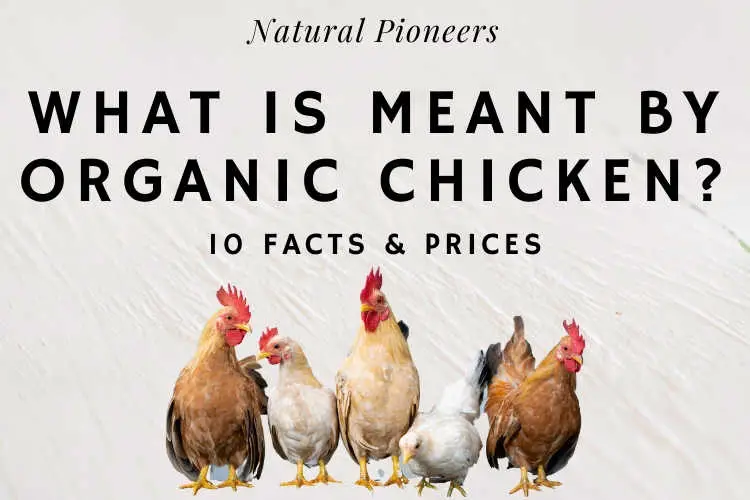
Food labeling and the term organic have been causing a lot of confusion. Commonly asked questions are: Is organic better for us? And is it worth the price? The following 10 facts will answer all your questions and leave you with no doubts.
Organic chicken means that the chicken was raised according to the USDA Organic Standard. This includes but is not limited to the highest standard in animal welfare, 100% Organic feed, no use of hormones, antibiotics or GMOs, and meat higher in Omega-3’s due to a partially grass-fed diet.
There is a whole lot more to know about organic chicken. Let’s find out!
1. What Organic Labelling Means In Chicken
Organic is a labeling term that indicates that the chicken has been produced through methods approved by the USDA Organic Standard.
These methods…
- Foster cycling of resources
- Promote ecological balance
- Conserve biodiversity
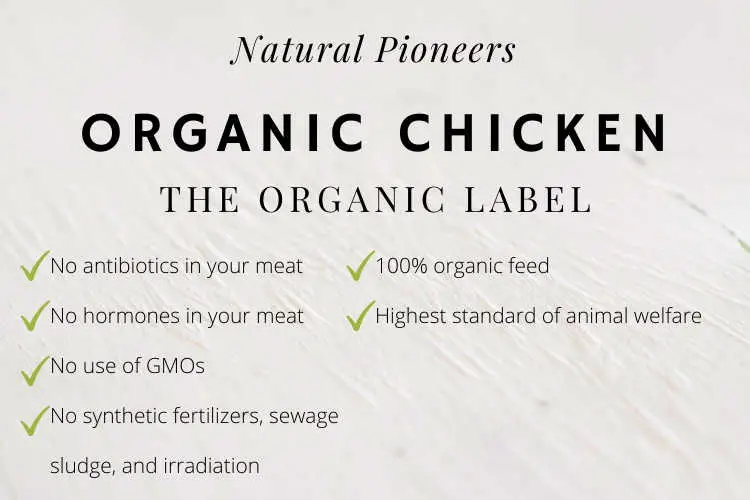
When opting for more expensive, organic chicken at the store this means you ensure:
- No antibiotics in your meat
- No hormones in your meat
- Highest standard of animal welfare: Free-range birds with access to outdoor ranges
- Smaller flocks sizes
- 100% organic Feed
- No use of GMOs (genetically modified organisms)
- No use of synthetic fertilizers, sewage sludge, and irradiation
It is important to know, that no system of farming has higher animal welfare standards than the USDA Organic Standard.
2. There Is A Nutritional Difference
Is organic chicken healthier? Let’s see what studies found out.
- A meta-analysis based on sixty-seven published studies found that organic meat contained higher amounts of polyunsaturated fatty acids (+23%) and omega-3 fatty acids (+47%). The high grazing diets in organic farming may be the reason for these differences. [1]
- One study found that low doses of antibiotics routinely used in conventional farming favor the emergence of resistant bacteria in animals. Resistant bacteria can be transferred to humans through (…) human consumption of meat, eggs and milk with resistant bacteria. [2]
- One study suggests that the intake of commercial chicken feed and commercial chicken meat may be the potential cause of development of polycystic ovary syndrome in females due to steroid hormonal imbalance. [3]
- One review based on organic management practices in the EU concludes that organic food consumption may reduce the risk of allergic disease and of overweight and obesity. Of concern is the prevalent use of antibiotics in conventional animal production as a key driver of antibiotic resistance in society. [4]
Conclusion: Yes, organic chicken is healthier. The nutritional profile shows significantly higher amounts of healthy omega-3’s. Organic chicken also protects you from developing antibiotic resistance and may protect women from developing polycystic ovary syndrome. Furthermore, allergic diseases and obesity may be reduced when making the switch to organic chicken.
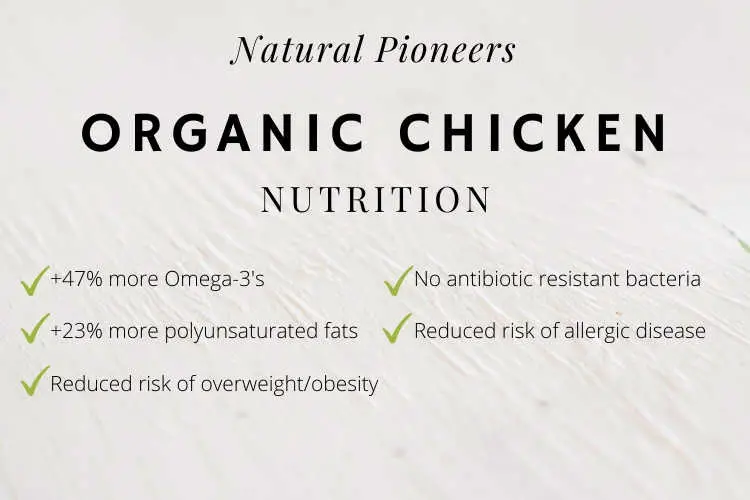
3. Organic Chicken Is Raised Naturally
Does organic chicken come from happy hens?
USDA Organic Regulations require that animals are raised in living conditions accommodating their natural behaviors, like the ability to graze on pasture.
Generally, organic poultry production in the United States is based upon two models: pastured operations and house- or barn-based systems.
Animal health is the result of preventative and on-going management efforts to create living soils, provide nourishing forage and feed, and improve the quality of livestock life.
Ever wondered what “natural” yogurt is? Find out more: What’s The Price Of Natural Yogurt? Buyer’s Guide & Prices
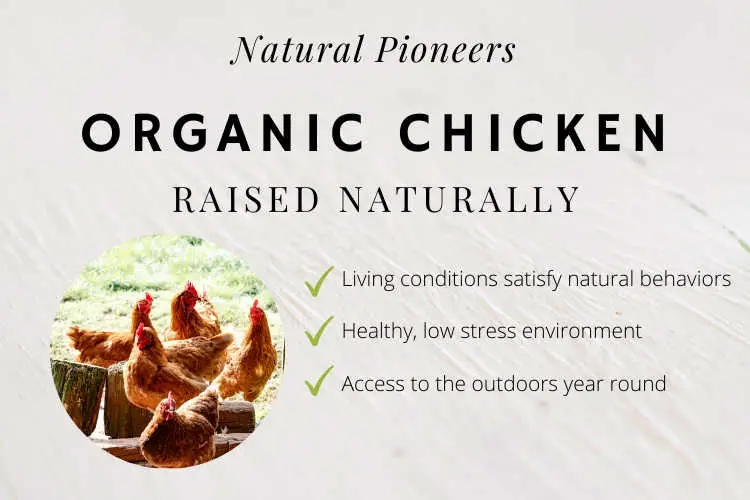
Animals must be kept in healthy, low stress environments. Producers must use preventative health care practices and may only use approved treatments.
Housing must provide access to the outdoors, shade, shelter, exercise areas, fresh air and direct sunlight year round. Housing must also provide adequate protection from predators.
Conclusion: Yes, organic chicken comes from happy hens. They have access to the outdoors year round, graze on pasture, and get high quality organic feed.
4. Organic Chicken Is Fed 100% Organic, Non-GMO Feed
Is organic chicken Non-GMO?
As with all organic foods, it is not grown or handled using GMOs (genetically modified organisms). Antibiotics, animal by-products and synthetic preservatives are not permitted in any feed products either.
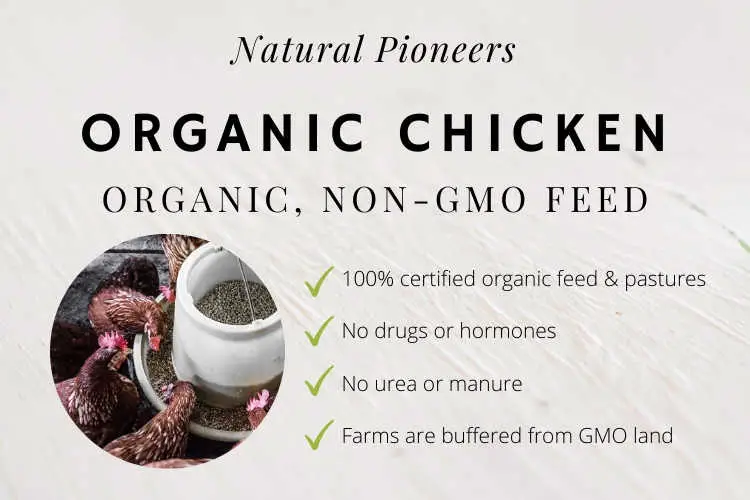
The hens get:
- 100% certified organic feed, including pastures
- Water additives (electrolytes, molasses, cider vinegar, etc.)
- Minerals and vitamins only after approval
To prevent GMOs from being introduced into organic production, producers do not use GMO seeds or other materials when planting crops.
They also work with their certifiers to implement preventative practices that effectively buffer their farms from GMO contamination.
Conclusion: Yes, organic chicken is Non-GMO. The use of GMOs is not allowed in any organic product.
5. Organic Chicken Is Free of Antibiotics and Hormones
What about hormones and antibiotics?
Antibiotic resistance is a global health concern. The number of bacteria that are resistant to antibiotics is increasing.
In humans, antibiotic resistance results in a decreased ability to treat infections and illnesses. That means commonly prescribed antibiotics no longer work for resistant people.
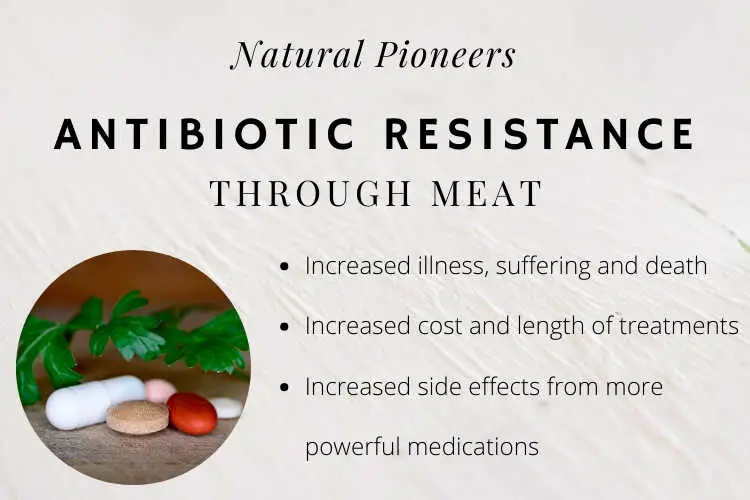
One study was concerned about the prevalent use of antibiotics in conventional animal production as a key driver of antibiotic resistance in society. [5]
Consuming conventional, antibiotic treated chicken can be one of the causes of antibiotic resistance in humans.
As a result, antibiotic resistance leads to…
- increased human illness, suffering and death rates,
- increased cost and length of treatments, and
- increased side effects from the use of multiple and more powerful medications.
As mentioned earlier, studies suggests that the intake of commercial chicken feed and commercial chicken meat may be the potential cause of development of polycystic ovary syndrome in females due to steroid hormonal imbalance. [6]
Conclusion: Organic Chicken is free of antibiotics and hormones. Organic consumers don’t get in contact with antibiotics or hormones. Choosing organic meat is a key factor when trying to avoid developing antibiotic resistance.
6. Processed Organic Products: 4 Different Labels
What do all these different labels mean?
When it comes to processed, multi-ingredient foods, the USDA Organic Standard specifies additional considerations.
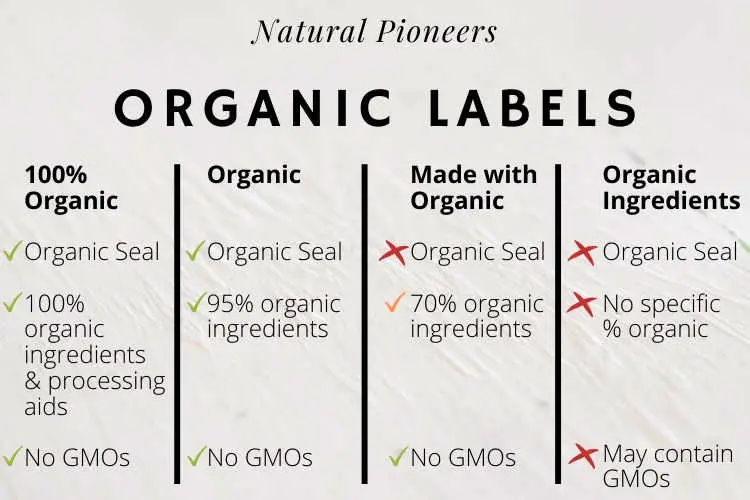
- The “100% Organic Logo” means that all contained ingredients are 100% organic and Non-GMO. All ingredients comply with the National List of allowed and prohibited substances.
- The “Organic Logo” means that 95% of the contained ingredients are organic. Products with this label are Non-GMO. The Non-organic ingredients have to comply with the National List as well.
- Sometimes you’ll find products that state “Made with Organic” on the packaging. This means that at least 70% of the contained ingredients are organic. Products with this label are Non-GMO. The Non-organic ingredients have to comply with the National List as well. These products cannot carry the USDA Organic Logo.
- Finally, there are products that state “Organic Ingredients” on their packaging. These products do not specify a percentage showing how much of the product is organic. These products may also include GMO ingredients. There is no compliance with the National list, and they are not allowed to have the Organic Logo printed on their product.
Curious about the differences between organic and Non-GMO eggs? Find out more: Organic vs. Non-GMO Eggs | Differences & Price Comparison
Conclusion: Choosing products with seals “100% Organic” and “Organic” are more safe and of the highest quality. “Made with Organic” and “Organic Ingredients” products can’t use the USDA Organic seal and may contain GMOs.
7. Organic Chicken Is In Parts Grass Fed
Is organic chicken grass-fed?
Grass-fed meat has grown in popularity, not only by the Paleo community. Grass-fed animals receive a majority of their nutrients from grass throughout their life.
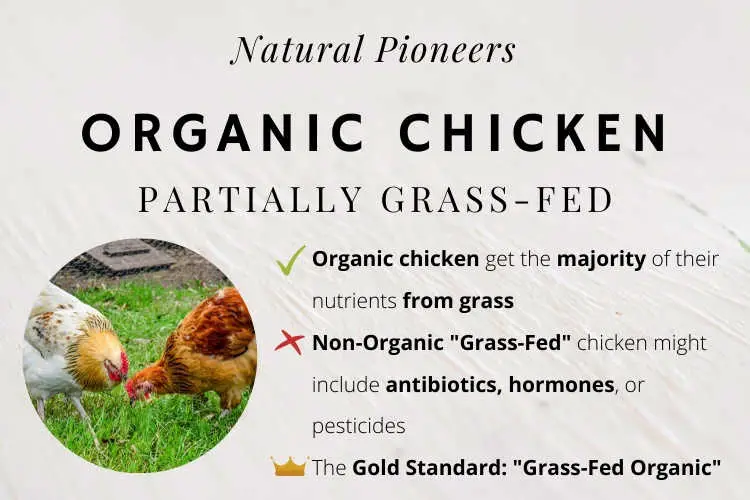
Meat labeled “Organic” comes from animals with a pasture diet that may be supplemented with grain.
Be aware, that a product with only the grass-fed label does not limit the use of antibiotics, hormones, or pesticides.
The gold standard for chicken and other meat is the label “grass-fed organic”.
Conclusion: Yes, organic chicken receives the majority of their nutrients from grass.
8. Chicken Can Be Labeled “Organic” Without Being Certified
Generally, producers need to be certified in order to claim that their products are organic.
The USDA specifically states: “If you are not certified, you must not make any organic claim on the principal display panel or use the USDA Organic Seal anywhere on the package.”
Without certification, producers may still show some ingredients which are certified organic and the overall percentage of organic ingredients.
There is one exception: Some operations are exempt from certification, including organic farmers who sell $5,000 or less.
You might therefore still find organic products without the original USDA Organic seal. Your local farmers market might be a place where you can find those.
9. Prices of Organic Chicken
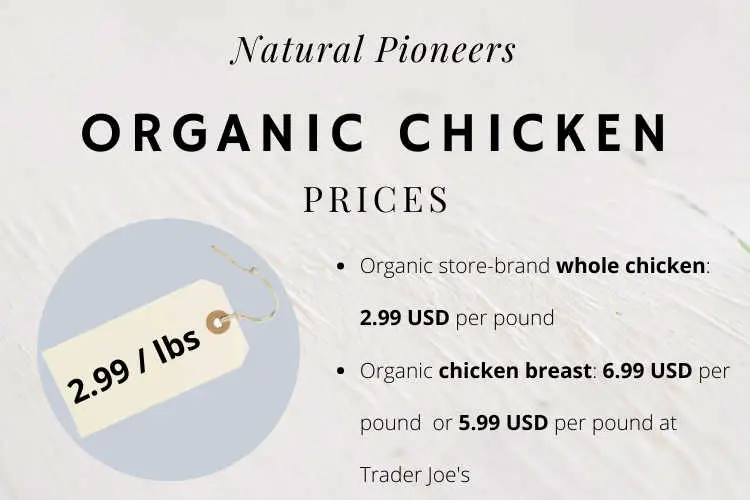
Is organic chicken more expensive?
Feed is the greatest expense in any poultry operation, regardless of whether it is conventional or organic.
Organic grain prices are typically double or triple the price of conventional grains. As a result, higher expenses for feed and complying with all other regulations makes organic chicken more expensive.
In 2020, the price of organic store-brand chicken is about 2.99 USD per pound. Organic chicken breast can be found for 6.99 USD per pound at the store and for 5.99 USD per pound at Trader Joe’s.
As a comparison, non-organic, “conventional” whole chicken cost about 2.29 USD per pound (1.99 at Trader Joe’s) and the price of non-organic “conventional” chicken breast is 4.99 USD at Ralph’s (4.49 at Trader Joe’s).
| Organic Chicken Breast | Organic Whole Chicken | |
| Any Store-Brand | 6.99 USD/lbs | 2.99 USD/lbs |
| Trader Joe’s | 5.99 USD/lbs | 2.99 USD/lbs |
Conclusion: Yes, organic chicken is more expensive than conventional, “regular” chicken. Organic chicken breast costs about $ 1.50 more per pound.
10. Getting What You Pay For Is Easy
If you are looking for organic chicken at the store, simply look out for the USDA Organic Seal.
Don’t let yourself get distracted by other claims like “All-Natural” or natural-looking green packaging.
Picking a product with the USDA Logo “100% Organic” or “Organic” ensures that you’re on the safe side.
Sources
- https://www.ams.usda.gov/sites/default/files/media/LivestockProducersGuide.pdf
- https://www.usda.gov/media/blog/2012/03/22/organic-101-what-usda-organic-label-means
- https://www.ams.usda.gov/rules-regulations/organic/labeling
- https://www.ams.usda.gov/sites/default/files/media/What%20is%20Organic.pdf
- https://www.usda.gov/media/blog/2011/12/16/organic-101-what-organic-farming-and-processing-doesnt-allow
- https://www.ams.usda.gov/sites/default/files/media/Poultry%20-%20Guidelines.pdf
- https://www.soilassociation.org/organic-living/why-organic/better-for-animals/poultry-chickens/
- https://www.soilassociation.org/organic-living/why-organic/better-for-the-planet/
- https://www.soilassociation.org/organic-living/why-organic/better-for-wildlife/

